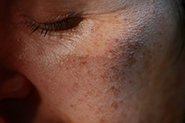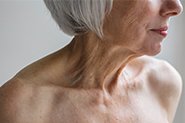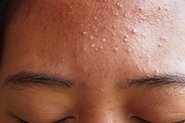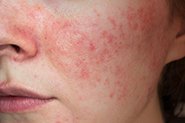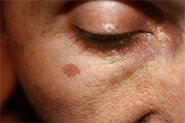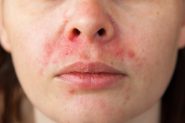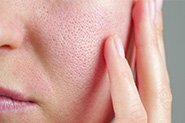
Our neck skin is one of the first areas to show signs of sun damage – here’s our guide to understanding the factors that contribute to neck skin ageing, and what you can do about it!
Do we need to treat the skin on our neck differently to our face?
The aging neck is an interplay of both quality of the skin itself and how the skin drapes over the supporting structures below the skin (fat, muscle, bone) [1]. So even if neck contours are addressed using surgical or non-surgical techniques, rough, textured, sun damaged skin will negatively affect the overall perception of a youthful neck. This is why treatment plans to target the aging neck must take skin quality into account.
Neck skin is subject to the same intrinsic and extrinsic aging factors as skin elsewhere on the body (more detail about these factors HERE), the most important of these being UV induced skin aging (‘photodamage’ or ‘photoaging’). Around 90% of the changes we see in aged skin (rough, dry, deeply wrinkled, saggy skin with uneven texture and tone, depigmented white spots called ‘guttate hypomelanosis’ and broken vessels) are cumulative damage from chronic exposure to the sun’s UV radiation.
But because the neck is difficult to protect from the sun (and often forgotten in our daily skincare and sunscreen routines until it’s too late), cumulative sun exposure results in pigmentary, vascular and texture changes that are particular to this part of the anatomy:
1. Poikiloderma of Civatte: patchy hyper- and hypo-pigmentation and broken vessels (telangiectasia) on the sun-exposed sides of the lower face, neck and V of the chest. There is typically a non-pigmented area under the chin, where the neck is shaded. PC usually occurs in fair-skinned people aged 40+, especially females, and may be made worse by spraying perfumes or using fragranced cosmetics in this area.
2. Deep wrinkling on the back of the neck called cutis rhomboidalis nuchae, named after the rhomboid shape of the wrinkles.
And finally, although neck skin is more elastic and ‘stretchy’ than facial skin to allow free movement of the head and neck,[2] this repetitive movement, combined with photodamage and the downward pull of neck muscles and gravity, makes the neck skin more prone to deeper wrinkles than the face (fivefold deeper in one study [3]).
Is there anything particular to keep in mind when treating the neck area with skincare products?
Several studies have demonstrated that transepidermal water loss (a reflection of skin barrier function) increases with age in neck skin [3,4]. This suggests that skin barrier function decreases with age, and correlates with anecdotal reports from consumers that neck skin is more sensitive with age. In a practical sense, this means taking care with skincare products in this area, as it is more prone to reactions.
So instead of looking for quick fixes, think about skincare as a long game – regular application of active skincare products (especially prescription retinoids) as frequently as tolerated will still produce results in the long term. If you’re a Qr8 MediSkin patient, click HERE to book a support chat with our nurse to discuss a personalised plan for this area (it’s already part of the service you have paid for!)
Are there any preventative things we can do to reduce premature ageing of the neck area?
At Qr8 MediSkin, we teach patients to treat the skin of their face, neck (front and back) and chest as a single unit when applying skincare or treatments – we call this area ‘The French Face’.
We also recommend a dual preventative approach involving starting topical prescription retinoids to repair UV skin damage well before photodamage is visible (the microscopic signs of sun damage are present by our early 20s in Australia), and proper use of SPF50 sunscreen, protective clothing and wide-brimmed hats. Keeping fragranced products and perfumes away from this area can also help prevent reactions that can lead to neck pigmentation.
But don’t worry about sweeping skincare on in an upward direction to reduce neck sagging or wrinkling. Skin is designed to stretch and bounce back, so applying skincare in either an upwards or downwards direction will have no effect, positive or negative, unless you’re doing it for hours every day. This is especially true given the other wrinkle-inducing forces at play in this area.
Anything else important to know about the skin on our neck?
The horizontal neck folds that are a hallmark of ‘Tech neck’ are actually present in normal skin before 20 years of age. But they do increase in severity with age – one study [5] showed that they are the first sign of aging to appear in neck skin, becoming significantly noticeable in the 26-30 year old age group, well before other signs such as neck sagging, skin changes, and appearance of platysmal bands. So paying attention to posture when using technology (but also any activity that requires prolonged neck flexion, such as reading a book) should form part of an overall neck aging prevention strategy.
Don’t worry about tech neck pigmentation though – the dose of blue light from artificial sources is too low to impact pigmentation (even after 8 hrs of daily exposure to a computer screen for 5 days [6,7])
What if the damage has already been done?
It’s never too late to start with topical treatments – crepey skin and pigmentary changes can be addressed with this kind of treatment. And our team can also provide advice on what non-surgical treatments actually work to target other changes in this area.
Is the neck skin really ‘thinner’ than facial skin? CLICK HERE for more information.
REFERENCES
- Shadfar S, Perkins SW. Anatomy and physiology of the aging neck. Facial Plast Surg Clin North Am. 2014. PMID: 24745379.
- Firooz A, Sadr B, et al. Variation of biophysical parameters of the skin with age, gender, and body region. Scientific World Journal. 2012. PMID: 22536139.
- Kim E, Cho G, et al. Age-related changes in skin bio-mechanical properties: the neck skin compared with the cheek and forearm skin in Korean females. Skin Res Technol. 2013. PMID: 23441628.
- Nedelec B, Forget NJ, et al. Skin characteristics: normative data for elasticity, erythema, melanin, and thickness at 16 different anatomical locations. Skin Res Technol. 2016. PMID: 26333046.
- Xie X, Wang Y et al. Characteristic features of neck skin aging in Chinese women. J Cosmet Dermatol. 2018. PMID: 30160008.
- Duteil L, Cardot-Leccia N, et al. Differences in visible light-induced pigmentation according to wavelengths: a clinical and histological study in comparison with UVB exposure. Pigment Cell Melanoma Res. 2014. PMID: 24888214.
- Duteil L, Queille-Roussel C, et al. Short-term exposure to blue light emitted by electronic devices does not worsen melasma. J Am Acad Dermatol. 2020. PMID: 31887321.


